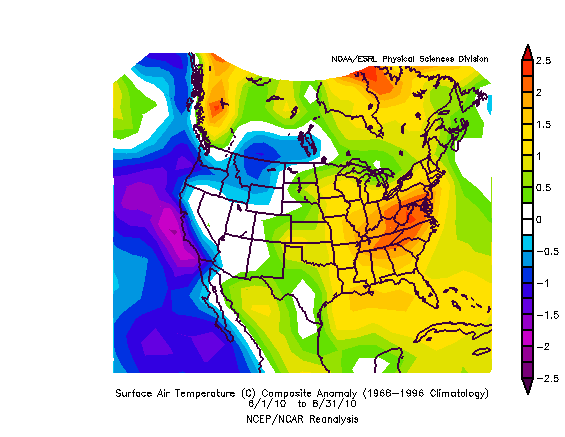Heat in the Southeast
Cross-posted at Highly Allochthonous
Here in Charlotte we had a hot summer. We barely escaped the dubious distinction of hottest summer on record, with an average temperature of 81.1° F (27.3 ° C) between 1 June and 31 August. The record had been set in 1993, when Charlotte recorded an average temperature of 81.5° F (27.5 ° C). In terms of record breaking heat, we actually fared better than many parts of the east coast, where temperature records from New York City to Greenville-Spartanburg, South Carolina were broken. Below there’s a nice map from NOAA of how far average temperatures deviated from the 30-year climate normal period (here, 1966-1996).

U.S. surface temperature departure from average (°C), June 1 to August 31, 2010, from NOAA/ESRL Physical Sciences Division, Boulder Colorado
Of course those average temperature records belie the minima and maxima experienced by each place over the course of those three summer months, so there’s another statistic that I’m finding even more interesting: the number of days where maximum temperatures exceeded 90° F (32.2 ° C). I think of it as Anne’s index of intolerable heat, especially when combined with the Southeast’s oppressive humidity. In Charlotte, between 1 June and 31 August, we had 67 days that exceeded 90° F. That means that 73% of days this summer were intolerably hot (at least for me). Also, that’s only counting the days in the climatological summer. We had 90+° F degree heat in early April, some in May, and we’ve already had some in September, with more in the forecast this week. I suspect that by the time the year is out, our total days above 90° F will be something around 80, if not more.
The long-term predictions for the index of intolerable heat look grim for Charlotte and the rest of the southeast. The image below shows historical and modeled days with peak temperatures exceeding 90° F. By the end of the century, at least under a high emissions scenario, 80+ days of intolerable heat will be considered a cool summer in North Carolina. We’re heading towards 120 days or more of hot, hot weather, a doubling of our historical average. In parts of Florida and Texas, more than half the year will be hotter than 90° F. Yuck. Glad I won’t be around here then.

These temperature trends are not just bad news for people who like to play (or do field work) outside in the summer, but are too wimpy to drop bucketloads of sweat. Hotter average temperatures and more days with ridiculous heat have real health consequences. On hot days, the chances go up that people playing outside end up with heat exhaustion or life-threatening heat stroke. People without air conditioned homes or workplaces, people too poor to pay tremendous energy bills for air conditioning, or people who just happen to have their AC break do not even need to play outside to be at risk of heat related illness or death. About 700 people already die each year from heat-related causes, and the elderly are a disproportionate share of the victims. Those with cardiovascular disease are also at substantially increased risk of heat-related mortality.
And it’s not the heat alone that spells bad news for the Southeast. With hotter temperatures come increasing rates of photochemical reactions…such as the production of ground-level ozone from nitrous oxides and volatile organic compounds released by car exhaust, power plants, and natural sources. The chemistryof photochemical ozone production is pretty complex and we don’t have a fantastic handle on how coming climate changes will impact the percent of hot days with sun versus clouds, but if the number of hot sunny days increases, it is likely that ozone production will increase too. Ozone brings its own host of adverse health effects, particularly respiratory problems, so even if you don’t mind the heat, running around outside on hot, sunny days can be a bad idea. Once again, children, the elderly, and those with asthma and other respiratory problems are most at risk on high ozone days. Such days, labeled as orange alerts, occur sporadically thoughout the summer already. In Charlotte, we’ve had 13 days with air quality in the orange category since May 1 this year. On those days, people at risk are encouraged to avoid outdoor exercise, and daycare centers limit the time kids spent playing outside. Some days, the air quality is bad enough (red alert) that even healthy adults are encouraged to avoid to outdoor exercise. That’s happened once this year in Charlotte.
As Charlotte and other parts of the southeast move towards one-third of their days in the intolerably hot range, with the probable added bonus of worse air pollution, it will be interesting to watch the societal shifts in attitudes toward the climate. Will Southerners get serious about reducing emissions from cars? Will Charlotteans end their love affair with sprawl in order to improve air quality? Will the Southeast be depopulated of Yankee transplants like me, who finally decide that they can’t take the heat? Or will we just stay inside and crank up the air conditioning units and complain about the weather?
